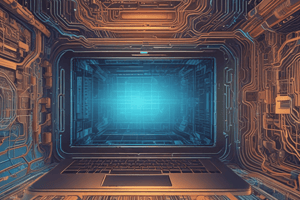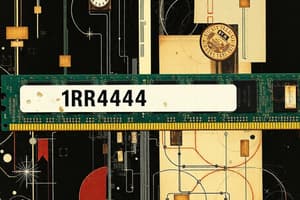Podcast
Questions and Answers
What is the primary advantage of using SRAM for cache memory?
What is the primary advantage of using SRAM for cache memory?
- Low latency (correct)
- High storage capacity
- Low power consumption
- Fast refresh rate
What is the purpose of multiplexing address lines in DRAM?
What is the purpose of multiplexing address lines in DRAM?
- To reduce power consumption
- To separate row and column access (correct)
- To improve access time
- To increase storage capacity
What is the primary concern of cache memory in terms of performance metrics?
What is the primary concern of cache memory in terms of performance metrics?
- Cycle time
- Latency (correct)
- Bandwidth
- Access time
Why are DRAM chips organized into many banks?
Why are DRAM chips organized into many banks?
What is the typical refresh rate for DRAM?
What is the typical refresh rate for DRAM?
Why are Flash drives preferred over disk drives for power management devices (PMDs)?
Why are Flash drives preferred over disk drives for power management devices (PMDs)?
What is the primary advantage of using SRAM over DRAM?
What is the primary advantage of using SRAM over DRAM?
What is the minimum time between unrelated requests to memory referred to as?
What is the minimum time between unrelated requests to memory referred to as?
What is the main advantage of stacked DRAMs?
What is the main advantage of stacked DRAMs?
What is the main difference between NAND and NOR flash memory?
What is the main difference between NAND and NOR flash memory?
Why is NAND flash faster than magnetic disks?
Why is NAND flash faster than magnetic disks?
What is a limitation of NAND flash memory?
What is a limitation of NAND flash memory?
What is the main issue with memory capacity and speed according to Amdahl's law?
What is the main issue with memory capacity and speed according to Amdahl's law?
What is the main advantage of Phase-Change/Memristor Memory?
What is the main advantage of Phase-Change/Memristor Memory?
What is the primary advantage of Synchronous DRAM (SDRAM)?
What is the primary advantage of Synchronous DRAM (SDRAM)?
What is the main difference between DDR and DDR2?
What is the main difference between DDR and DDR2?
Why are DDR3 SDRAMs faster than previous SDRAMs?
Why are DDR3 SDRAMs faster than previous SDRAMs?
What is the main difference between SDRAM and magnetic disks?
What is the main difference between SDRAM and magnetic disks?
What is the primary benefit of DDR5 over DDR4?
What is the primary benefit of DDR5 over DDR4?
What is a characteristic of DDR3 SDRAMs?
What is a characteristic of DDR3 SDRAMs?
How do low power mode SDRAMs reduce power consumption?
How do low power mode SDRAMs reduce power consumption?
What is the main advantage of Graphics memory (GDRAMs or GSDRAMs)?
What is the main advantage of Graphics memory (GDRAMs or GSDRAMs)?
Flashcards are hidden until you start studying
Study Notes
Memory Optimizations
- Amdahl's law states that memory capacity should grow linearly with processor speed, but this has not been the case.
- Optimizations include:
- Multiple accesses to the same row
- Synchronous DRAM (SDRAM) with a clocked interface, burst mode, and critical word first
- Wider interfaces
- Double data rate (DDR)
- Multiple banks on each DRAM device
DDR Memory
- DDR2:
- Lower power consumption (2.5 V → 1.8 V)
- Higher clock rates (266 MHz, 333 MHz, 400 MHz)
- DDR3:
- 1.5 V
- 800 MHz
- DDR4:
- 1-1.2 V
- 1333 MHz
- GDDR5 is a graphics memory based on DDR3
- DDR5 starts at 4800MT/s, with planned speeds up to 8800MT/s, representing a 50% increase in bandwidth over DDR4.
Dual Inline Memory Modules (DIMMs)
- DIMMs are used to organize DRAM devices into multiple banks for high bandwidth.
Reducing Power in SDRAMs
- Methods include:
- Lower voltage
- Low power mode (ignoring clock, only refreshing)
Graphics Memory (GDRAMs or GSDRAMs)
- Achieve 2-5 times bandwidth per DRAM compared to standard DRAM.
Random Access Memory (RAM)
SRAM
- Requires low power to retain bit
- Requires 6 transistors/bit
- No need to refresh
- Access time is close to cycle time
DRAM
- Must be re-written after being read
- Must be periodically refreshed (every ~ 8 ms)
- One transistor/bit
- Address lines are multiplexed:
- Upper half of address: row access strobe (RAS)
- Lower half of address: column access strobe (CAS)
Internal Organization of DRAM
- Typical 16-Mbit DRAM (4M X 4) organized in banks
- Only 4 bits are written at a time; more bits require more DRAM devices.
Memory Technology
- Performance metrics:
- Latency (concern for cache)
- Bandwidth (concern for multiprocessors and I/O)
- Access time
- Cycle time
- SRAM is used for cache due to low latency
- DRAM is used for main memory, organized in banks for high bandwidth
- PMDs use Flash memory due to modest storage needs and balance of power and performance.
Stacked/Embedded DRAMs
- Stacked DRAMs in the same package as the processor
- High Bandwidth Memory (HBM)
Flash Memory
- Type of EEPROM
- Types: NAND (denser) and NOR (faster)
- NAND Flash:
- Reads are sequential, reading entire pages (0.5 to 4 KiB)
- 25 us for first byte, 40 MiB/s for subsequent bytes
- Faster than magnetic disk (300 to 500X)
NAND Flash Memory
- Must be erased (in blocks) before being overwritten
- Nonvolatile, can use as little as zero power
- Limited number of write cycles (~100,000)
- Relatively inexpensive ($2/GiB) compared to SDRAM and magnetic disk.
Studying That Suits You
Use AI to generate personalized quizzes and flashcards to suit your learning preferences.




